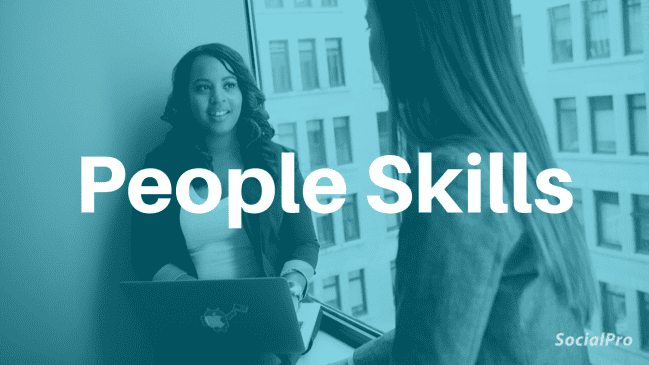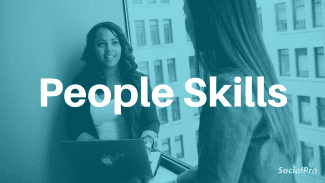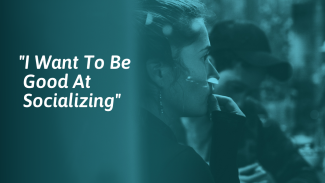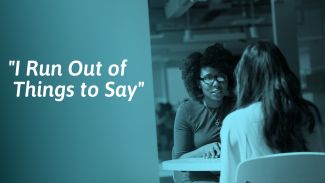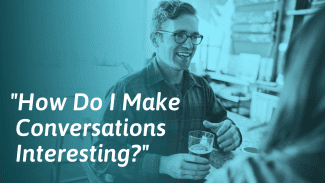I used to see others connect and make new contacts with ease, while I felt stiff and clueless around people.
Still, I knew how important people skills were, both at work and in personal life. I committed to becoming good at it. A degree in psychology and years of training later, this is what I’ve learned.
1. Make eye contact and smile
Before I say a word to someone new, I make eye contact and give them a natural smile. It’s not a full grin, just a gentle smile that lifts the corners of my mouth and produces subtle crow’s feet near my eyes. Making eye contact and smiling shows that I’m friendly and open to conversation.
2. Relax your face
Facial expressions are the signals that tell others how we’re feeling. When I meet new people I try to have an open, neutral expression. However, when I’m nervous my face can tense up and I start frowning. It’s also jokingly described as RBF (Resting Bitch Face, which can happen to both genders by the way). To combat this, I relax my jaw and make sure that I don’t lower my eyebrows. This lessens the wrinkle between my brows and stops me from looking angry. Instant open expression!
Another trick is to in your mind see any new person as an old friend. When you do, your body language should follow automatically.
3. Make light conversation
Make some small talk, even if you don’t feel like it. I saw small talk as pointless, but it does have a purpose: It signals that you’re a friendly person and it’s a warm-up for more in-depth conversation in the future. It makes a big difference to say something simple like “What are you up to today?” or “How was your weekend?”.[1]
Here’s more detailed advice on how to start a conversation.
4. Seek out social situations
I know how uncomfortable social situations can feel. But to improve our people skills, we want to get exposure to those situations. Putting yourself in social situations (even if you don’t feel like it) is an effective way to improve your people skills.[2]
Join the others in the lunchroom at work. Say yes to social invites. Make small talk at the water boiler.
To me, an important realization was to see those moments as my training ground for being better socially in the future. That took the pressure off me to perform in each given social situation – it was just practice anyway.
5. Make remarks to keep conversations going
Quick positive comments about the things around you are great at keeping conversations going.
If you’re out walking and say “wow, cool architecture,” that can look like a mundane statement. But simple comments like those can lead to interesting new topics. Perhaps it leads the conversation into architecture, design, or what your dream house would look like.
6. Stick to topics that aren’t offensive
F.O.R.D. topics are Family, Occupation, Recreation, and Dreams. These topics help you get to know each other and form a connection.
R.A.P.E. topics are Religion, Abortion, Politics, and Economics. Personally, I think these topics can be interesting to talk about in a non-argumentative way with people you know well in the right settings. However, avoid them in light-hearted situations and with people that you don’t know well.
7. Show people that you care about them
If you meet a colleague after the weekend, is there something natural to bring up from the last time you spoke?
Examples of bringing up past topics:
- “Did you go on that weekend trip?”
- “Did your cold get better?”
- “Were you able to wind down despite that server problem?”
This shows that you listen and care. What was just small talk the last time you spoke now became more meaningful as you paid attention and remembered.
8. Build rapport
Building rapport is about sensing what someone’s like and being able to act in a way that’s appropriate to the situation. When two people have rapport, it’s easier for them to trust and like each other. Here’s a summary of what rapport is from Mindtools:
- Check Your Appearance: Make sure you look good and your clothes are appropriate for the situation. If you’re under- or overdressed, it can create a subconscious feeling in people that you’re not part of their group.
- Remember the Basics of Social Interaction: Smile, relax, use a good posture, talk about appropriate topics.
- Find Common Ground: Show genuine interest in your friend and you can discover things you have in common i.e. you attended the same school, you grew up in the same city or you support the same sport/team.
- Create Shared Experiences: To create rapport you need to interact with someone. This can happen when you work on a project together, grab a coffee or attend a class or conference together.
- Be empathetic: Being empathetic is demonstrating that you understand someone’s emotions when you see something from their perspective. To better understand someone, try asking them questions to learn how they think. Open-ended questions are best because they allow the speaker to fill in the details about how they feel when they answer.
Note: To keep the conversation balanced it’s a good idea to also share your thoughts with your partner on the topic. That will create a shared connection on the topic and avoid the feeling that it is an interview.
- Mirror and Match Mannerisms and Speech: If your friend is calm and you’re energetic, see if you can calm yourself down and meet their calmness. If they are being positive, you want to meet them in that positivity and not drag them down. Likewise, if someone’s sad or devastated, meet them in that sadness before you try to cheer them up. It’s not about imitating people in a mocking way: It’s about meeting them on their level.
Read our guide on how to build rapport.
9. Be supportive and give compliments
Pay attention to things that you think people are doing well, even if it’s just the effort of doing it, and praise them for it. Everyone appreciates kindness and support. By giving sincere compliments, it changes your relationship from professional acquaintances to something more human – you’re building a relationship.[3]
10. Be positive
Have a generally positive outlook on life when you talk to people. It can be easy to seek contact by complaining about something or being negative in general. However, studies show that too much negativity can hurt our friendships.[4,5] In my experience, negative people only make friends with other negative people. It’s not about being overly positive or fake. It’s about not making negativity a habit.
Try to be open and accepting of others and they will more than likely do the same for you. Be genuine. Find things you like about others and tell them. They will appreciate the thought and will dare to act in the same way toward you.
11. Listen rather than waiting for your turn to talk
Some are preoccupied thinking about what to say next as soon as someone else is talking. When they do, they miss out on the details of what someone says. Be fully focused when someone’s talking. It will shine through, and you will stand out as someone who really listens.
Ironically, it’s easier to come up with things to say when you fully focus on something. Just like when you get intrigued by paying close attention to a movie you really like, you’ll get more intrigued by conversations by paying close attention to them. When you listen closely it’s also easier to come up with questions and share related experiences.
Read more in our article on how to improve your social intelligence.
12. Use cues to show that you listen
Listening well is a skill. Showing that you listen is just as important. That’s when you listen to your partner and SHOW that you listen.
You do that by looking directly at the speaker, make listening sounds like “Uhm, hmm” when appropriate and laughing or reacting to what they are saying. It’s not about over-doing it or faking it. It’s about being immersed in what they say and showing it by giving authentic feedback. Show that you listen in one-on-one conversations, and in groups too. This is an effective way to be part of a group conversation even if you aren’t actively talking.
13. Know that people are full of insecurities
Even the most confident looking people aren’t confident about everything. In fact, everyone has insecurities. Look at this diagram, for example:
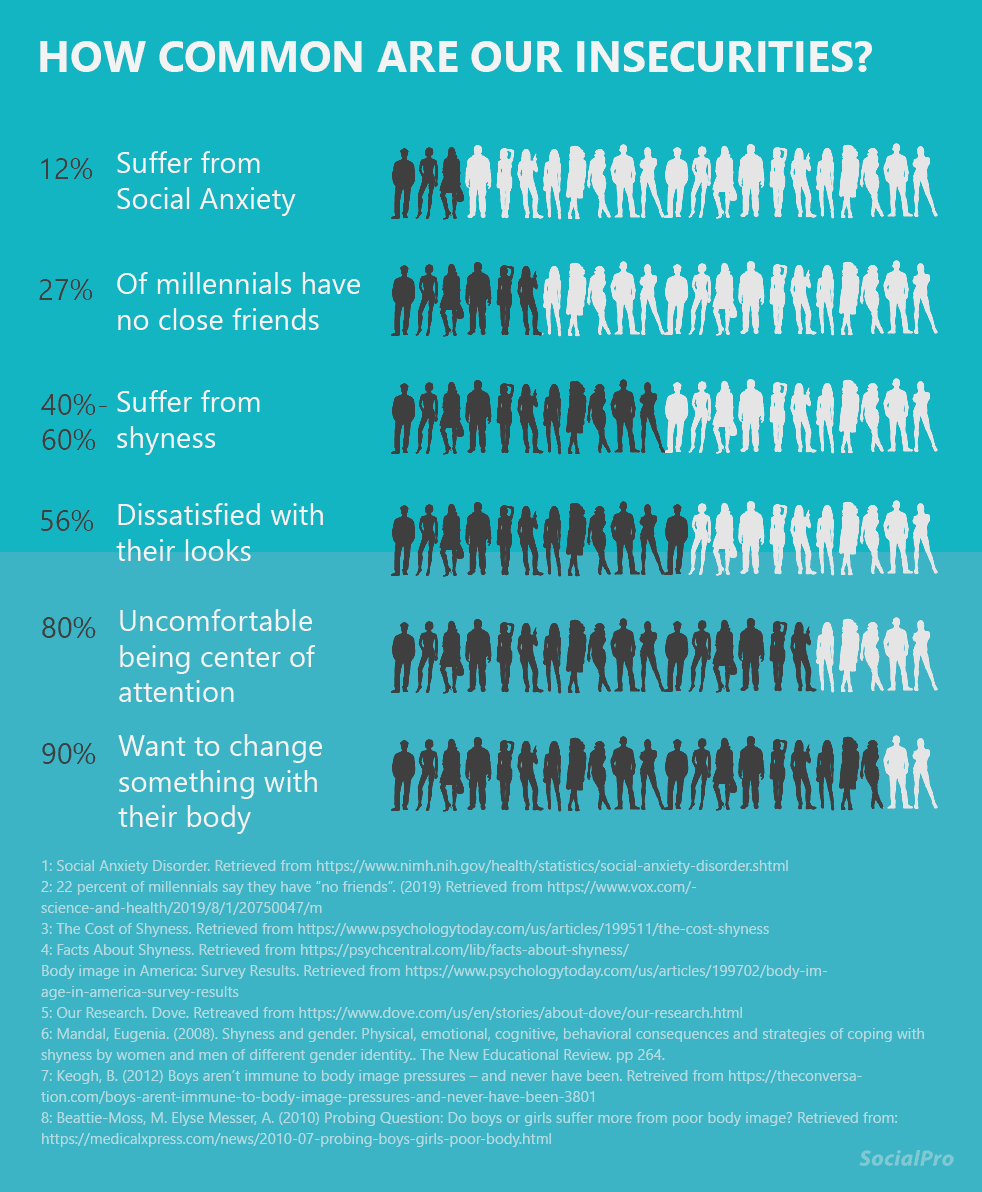
Knowing this helps us understand that we need to be warm and friendly for others to dare to open up and be friendly back.
The reverse is true as well: If you are critical and dismissive of others they will assume you dislike them and they will treat you in kind.
14. Gradually become more personal
For two people to get to know each other, they need to know things about each other. The secret to connecting is to, over time, switch from small talk to more personal topics.
Here’s how to do it: If you start out talking about the weather, you can mention that you love the fall and ask them about their favorite season. Now, you no longer talk about the weather, but you’re slowly getting to know each other.
Getting to know people is about being curious and learning about others while also getting to share stories about yourself.
15. Let people get to know you
Getting to know people is an exchange. It’s true that everyone loves to talk about themselves, but if the questions are only one-sided it can start to feel like an interrogation. When we share slightly personal things about each other we bond faster.
If someone asks you what you did on the weekend you could say, “I’m taking a class to learn Japanese” or “I just finished a book about World War II.” These phrases tell your partner what you’re interested in and open up bigger topics that you may have in common. If the conversation peters out just try a new topic, or go back to an old one that seemed to be more relevant to you both.
16. Observe others in social situations
This is the masterclass to learn how to be more socially savvy:
We all know someone who is great at talking with others and who sparks a social event just by arriving. What is it about them that makes them thrive in social situations?
When you meet someone who lights up a room with their presence, take a moment to see how they do it.
Here’s what I’ve learned from analyzing people with social skills:
- They are authentic: Meaning, they’re not trying to play a role of someone else.
- They show that they like the people who are there (both existing friends and strangers).
- They engage in what’s happening, ask questions, make comments, listen and learn.
- They show confidence, dare to walk up to people, and maintain eye contact.
Analyze those around you, and you might find out one or two things you can use later.
17. Read a book on people skills
Like reading this article, doing some research on the topic that you want to know more about and improve is a good thing. Here’s our list of the best books on social skills, ranked and reviewed.
These are my top 3 recommendations on that list:
- How to Win Friends and Influence People – Dale Carnegie
- The Charisma Myth: How Anyone Can Master the Art and Science of Personal Magnetism – Olivia Fox Cabane
- The Social Skills Guidebook: Manage Shyness, Improve Your Conversations, and Make Friends, Without Giving Up Who You Are – Chris MacLeod
You might like to go more specific reading this article on improving your people skills at work.
